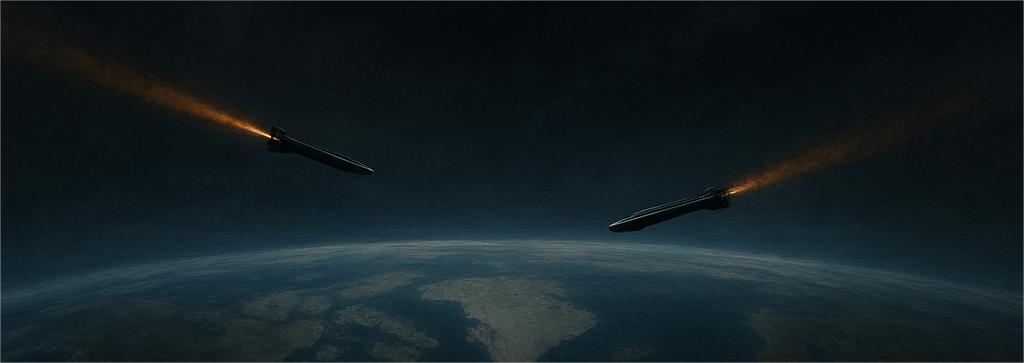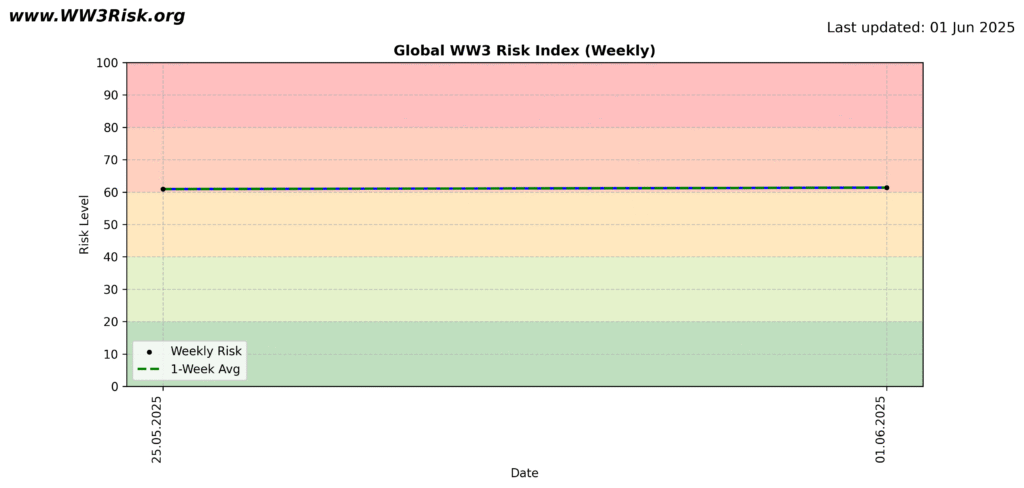
World War 3 Daily Risk Index
Here you can view the current World War III Risk Index score. This score is updated daily to reflect the most relevant and up-to-date global conflict indicators. It offers a quick snapshot of the current level of geopolitical tension and potential for large-scale conflict.
For a detailed explanation of how the score is calculated — including the data sources and methodology used — please visit the About page.

Historical Risk Trend
Below, you can view the historical trend chart for the World War III Risk Index. While the main risk score is updated daily, this chart is updated weekly to provide a clearer picture of how the risk level has evolved over time.
By tracking the weekly trend, visitors can observe broader shifts in global stability and understand how recent events have impacted the overall risk assessment.

Current Risk Assessment: High
The World War III Risk Index is currently in the High category, with a score above 60. This places it just above the threshold between Moderate and High, indicating a concerning but not yet critical level of global tension.
Being in the High risk category suggests that multiple indicators — such as armed conflict activity, military posturing, geopolitical instability, and deteriorating international relations — are collectively elevating the potential for large-scale conflict. While this score does not indicate that global war is imminent, it reflects a heightened state of volatility that warrants close attention.
Key contributing factors may include:
Escalations in ongoing regional conflicts
Increased military deployments or exercises near contested areas
Rising hostility between major global powers
Deterioration in diplomatic relations or international cooperation
Negative shifts in media sentiment and public discourse
Implications of a High Risk Rating:
A score in this range can signal a fragile global environment where the risk of miscalculation or escalation is greater than normal. It may lead to:
Heightened global alertness among policymakers and institutions
Increased defense spending and readiness activities
More volatile markets and investor uncertainty
Public concern or shifts in global migration and humanitarian planning
While not yet in the Critical range, continued monitoring is essential. A sustained upward trend could indicate an increasing likelihood of broader conflict if tensions remain unresolved.
Frequently Asked Questions About World War 3
Is WW3 Coming?
While no one can predict the future with certainty, rising global tensions, military buildups, and strained diplomatic relations have increased concerns about a potential large-scale conflict. The WW3 Risk Index tracks these developments daily to offer an up-to-date assessment of how likely such a conflict may be.
When will World War 3 start?
There is no definitive timeline or prediction for the start of World War 3. The aim of this site is not to forecast a specific date but to provide a real-time analysis of global risk factors that could lead to such an event, should conditions deteriorate.
What would happen if World War 3 started?
A global conflict would likely involve multiple world powers and could have catastrophic consequences — including mass casualties, economic collapse, cyber warfare, and widespread humanitarian crises. The goal of monitoring risk is to support awareness, dialogue, and prevention.
What countries would be involved in World War 3?
If World War 3 were to occur, it would likely involve current global power blocs and conflict zones. Key players could include the United States, Russia, China, NATO members, and nations in regions with ongoing tensions such as Eastern Europe, the Middle East, and the Asia-Pacific.
Want to explore more questions like “Who would win World War 3?” or “What countries might be destroyed?”
